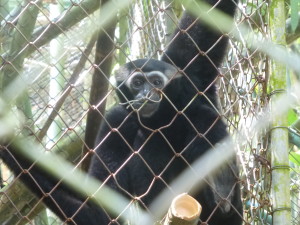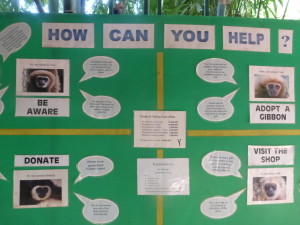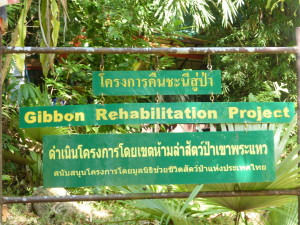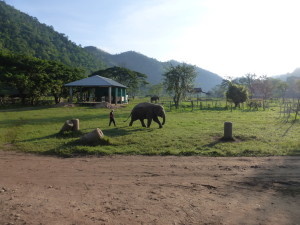Gibbons used to be plentiful in Thailand and through SE Asia, but they were poached for use and abuse in the tourist trade and as pets. Used mainly for photo opportunities for tourists who pay for a photo with a baby gibbon, native gibbons were poached to extinction on Phuket. The last gibbon on the island of Phuket was poached in the 1980s and conservationists have been working hard to try to reintroduce them to the area. By far the best resource around is the Gibbon Rehab Project here on Phuket Island in Southern Thailand. For more than twenty years, they have been working tirelessly to rescue and rehabilitate wild gibbons with the goal to release them back into their natural habitats. Laws have been passed to protect the gibbons but they are still fighting against the illegal poaching trade.
Before the rescue and rehab process though, the folks at the Gibbon Rehab Project fight to keep gibbons in the wild through education and conservation. Often a whole family of gibbons is killed in a poacher’s effort to get a baby gibbon as the family will fight to protect their baby. These gibbon babies might be cute, but they are still wild animals. When sexual maturity hits around the age of six or seven, gibbons grow sharp canines and often become aggressive. Often this is when they begin to be severely mistreated or chained and neglected. Unfortunately, although many are rescued by the Gibbon Rehab Project, many more die under these conditions. It is heartbreaking.
 Once rescued, they are brought to GRP and live in large cages where they can learn alongside other gibbons how to drink water with their hands (instead of bottles or cups as they may do in captivity), call to other gibbons, climb and play. Many of them have never had a chance to learn these skills. The rehab process is a slow process for many of them who have to be taught how to be wild. After several years, the gibbons are matched with suitable mates before eventually being released together as a family unit. Since inception, the GRP has released at least five family units and eleven new wild gibbon babies have been welcomed into these newly wild families.
Once rescued, they are brought to GRP and live in large cages where they can learn alongside other gibbons how to drink water with their hands (instead of bottles or cups as they may do in captivity), call to other gibbons, climb and play. Many of them have never had a chance to learn these skills. The rehab process is a slow process for many of them who have to be taught how to be wild. After several years, the gibbons are matched with suitable mates before eventually being released together as a family unit. Since inception, the GRP has released at least five family units and eleven new wild gibbon babies have been welcomed into these newly wild families.
All through SE Asia (and probably around the world), local people are using animals to make money in the tourist trade. Elephants are chained up all day with a heavy wooden platforms chained around them waiting for a tourist who wants a ride or a photo moment of themselves feeding them on the streets of Bangkok. Monkeys are chained up at restaurants to attract tourists. Large birds are chained on the back of a truck, allowing their owners to charge tourists for a photo. Animal circus shows are a dime a dozen as are Tiger Kingdoms, snake shows, elephant riding, etc. As we travel, we try very hard not to judge but when it comes to all the animals, I keep thinking there must be a better way than abusing these animals for a couple bucks.
 The best way that we tourists can help, of course, is to stop attending these types of venues. Stop going to the circus shows. Refuse photos with animals on the street. Don’t attend tiger shows where the animals are likely drugged. I know it is hard to resist sometimes as there are so many exotic animals to see that we can only imagine from books or movies. But, there ARE more humane alternatives.
The best way that we tourists can help, of course, is to stop attending these types of venues. Stop going to the circus shows. Refuse photos with animals on the street. Don’t attend tiger shows where the animals are likely drugged. I know it is hard to resist sometimes as there are so many exotic animals to see that we can only imagine from books or movies. But, there ARE more humane alternatives.
Go to places like Elephant Nature Camp where you can watch elephants wandering… gasp!…. free! There, guests can watch them live a life free from being ridden and free from sticks or chains. Our family spent one week volunteering at ENP back in November. It is an amazingly beautiful place and the elephants are clearly so well loved and cared for.
Or, you can visit places like the Gibbon Rehab Project here on Phuket where you can learn how to protect these gibbons. There is no fee to get in to see the gibbons or for the informational tour, but donations are appreciated to help support the project. Visitors can even adopt a gibbon to help offsets the costs of their care.


I am sharing this post. A lot of this abuse is due to human ignorance.
I agree–there has to be a better way to show appreciation for animals. On one hand, people relish in the opportunity to VIEW an animal that they wouldn’t otherwise see, but taking advantage of it and neglecting is certainly not the answer. The ENP sounds cool. In Chiang Mai we went to Patara Elephant Farm and had the experience of a lifetime. The day was centered around teaching the small amount of visitors (equal number of visitors as there were elephants) how to care for the elephants, check for signs of health, and determine what may be wrong with an elephant in bad health. It was a very cool way to turn the tourism interest into an educational and inspirational experience that benefits the animals.